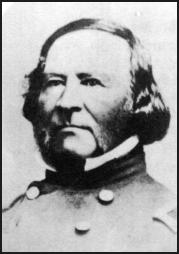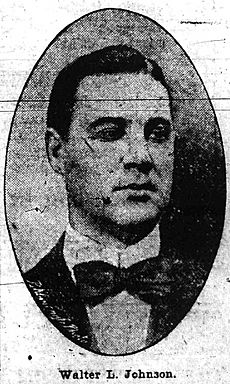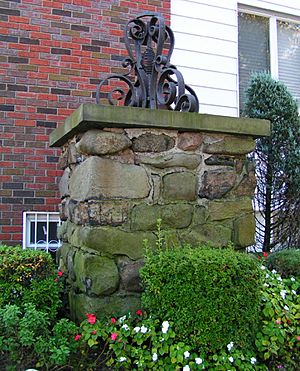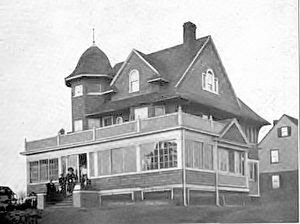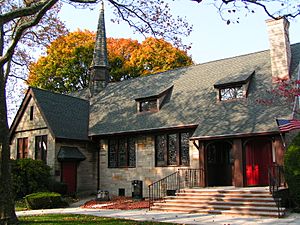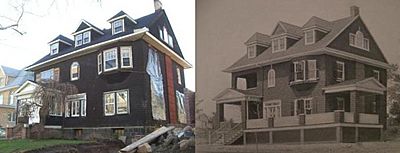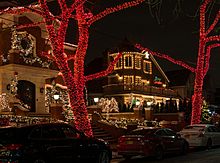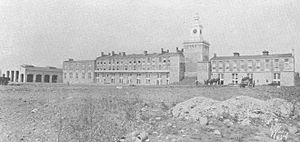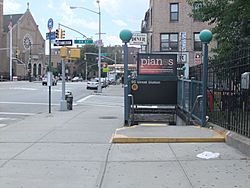Dyker Heights, Brooklyn facts for kids
Quick facts for kids
Dyker Heights
|
|
|---|---|
|
Neighborhood in Brooklyn
|
|

The Saitta House, an original Dyker Heights home
|
|
| Nickname(s):
Dyker
|
|
| Motto(s):
"The Handsomest Suburb in Greater New York"
|
|
| Country | |
| State | |
| City | |
| Borough | |
| Community District | Brooklyn 10 |
| Developed | 1895–1902 |
| Developer | Walter L. Johnson |
| Elevation | 51−110 ft (15.5−33.5 m) |
| Population
(2010)
|
|
| • Total | 42,419 |
| Time zone | UTC−5 (Eastern) |
| • Summer (DST) | UTC−4 (EDT) |
| ZIP Code |
11228
|
| Area code | 718, 347, 929, and 917 |
Dyker Heights is a neighborhood in the southwest part of Brooklyn, New York City. It sits on a hill, offering great views. This area is mostly residential, meaning it has many homes. It's known for its suburban feel, with houses that often have driveways and yards. This is pretty unique for New York City!
The neighborhood is bordered by 7th and 14th Avenues, 65th Street, and the Belt Parkway. Dyker Heights is famous for its amazing Christmas lighting displays each year. Many people visit to see the bright and colorful decorations.
Dyker Heights is part of Brooklyn Community Board 10. Its main ZIP Code is 11228. The New York City Police Department's 68th Precinct patrols the area.
Contents
History of Dyker Heights
How Dyker Heights Began
The land that is now Dyker Heights was once part of the Dutch town of New Utrecht, settled in 1657. For a long time, this area was just woodland. It was too hilly for farming. People used the trees for firewood and building materials. Later, the trees were cleared to grow vegetables like tomatoes and potatoes.
The first house on the highest point of the hill (around 11th Avenue and 82nd Street) was built in the late 1820s. It belonged to Brigadier General René Edward De Russy. He was a military engineer who built many forts, including Fort Hamilton in Brooklyn. He chose this spot because it had a clear view of the harbor and its defenses.
Building a New Community
After General De Russy's wife sold the property, it was bought by Jane Elisabeth Loveridge and Frederick Henry Johnson. Frederick Johnson was involved in real estate and wanted to develop the area. He helped bring New Utrecht into the City of Brooklyn in 1894.
After Frederick Johnson passed away, his son, Walter Loveridge Johnson, took over the family business. In October 1895, Walter started developing the land into a new community called "Dyker Heights." He named it after the nearby Dyker Meadow and Beach. The name "Dyker" might come from the Van Dykes family, who built dykes (walls) to drain the meadow.
Walter Johnson made many improvements to the area. He paved roads, added gas, water, telephone, and electricity lines. He also planted sugar maple trees along the streets. These changes created over 200 new building spots.
A Popular Place to Live
Walter Johnson was very good at promoting his new community. He advertised Dyker Heights as a beautiful suburb with great views. He said the high ground and ocean views made it the "handsomest suburb in Greater New York."
Newspapers agreed, praising his work. In 1896, Johnson built and sold 30 homes. By 1897, reports said he had made more sales than other nearby developments combined. People loved the location, which offered views from Sandy Hook to the New Jersey Palisades.
The Wall Street Journal even recommended Dyker Heights to busy people from Wall Street. They noted it was only a 45-minute trip by ferry and train. The article also highlighted the healthy climate and beautiful homes.
Rules for a Special Neighborhood
Walter Johnson set strict rules for building in Dyker Heights. Homes had to be built on large plots of land, at least 60 feet wide and 100 feet deep. Each house had to cost at least $4,000 and be set back from the street. These rules helped keep the neighborhood looking nice and exclusive.
One of the best features was the "uninterrupted view of the lower bay." This view of the water from The Narrows to the Atlantic Ocean was considered one of the best in the country. Many important people chose to move to Dyker Heights.
Later Years and Community Life
In 1906, a special home for blind babies was opened in Dyker Heights by the International Sunshine Society. This home helped start the first public kindergarten for blind children in New York City in 1907. This work led to important changes in how blind children were educated.
The Dyker Heights Club was another important part of the neighborhood. It had a large clubhouse designed by Albert Edward Parfitt. This building was later replaced in 1929.
Over time, the boundaries of Dyker Heights grew. Today, the neighborhood is known for its strong community spirit.
People and Culture
In 2010, the population of Dyker Heights was 42,419 people. Most residents are White (70.2%) or Asian (27.1%). A smaller group (5.9%) are Hispanic or Latino.
The neighborhood is home to many middle-aged adults and young people. The average life expectancy in this area is 83.1 years, which is higher than the average for New York City.
The median household income in Dyker Heights is about $68,679. Compared to other parts of the city, Dyker Heights is considered a higher-income area.
A Mix of Cultures
The first people to live in Dyker Heights were often wealthy professionals or government officials.
Since the 1940s, many people of Italian-American background have moved to Dyker Heights. They helped build the Roman Catholic Shrine Church of Saint Bernadette. Dyker Heights Boulevard, also known as 13th Avenue, is the main shopping area. It has many businesses owned by Italian-American families.
More recently, since the 2000s, more Asian residents have moved into the neighborhood. In 2020, for the first time, the Asian population became larger than the White population in Dyker Heights. There is also a growing Hispanic population.
Homes in Dyker Heights
Dyker Heights is known for its beautiful, large homes. Most are single-family houses, either detached (standing alone) or semi-detached (connected to one other house).
In 1899, the Brooklyn Eagle described a typical Dyker Heights home. It had five rooms on the first and second floors, and four rooms on the third. The first floor had high ceilings and fancy details like mantles made of wood. There was a large hall, a parlor (living room), a library, and dining rooms. The kitchen and washrooms had tiled floors.
The second floor had a sitting room and bedrooms, all with nice wood finishes. There was also a large bathroom. The third floor often had rooms for servants, a card room, or a billiard parlor.
About half of the original 150 homes built by Walter Johnson are still standing. Some have been torn down and replaced by new, larger homes or condos. Many of the older homes have also been updated and changed over the years.
Christmas Decorations in Dyker Heights
Dyker Heights is most famous for its incredible Christmas lights and decorations. Residents put them up every year, making the neighborhood a must-see during the holidays. It's often called the "capital of Christmas pageantry."
The whole community gets involved, not just a few houses. Many homeowners hire professional decorators to create amazing displays. These can cost anywhere from $1,000 to $20,000 or more! The decorators also offer to take down and store the lights.
The Christmas lights usually go up around the last Thursday of November (Thanksgiving). They stay lit until the first days of January. Mid-December is the busiest time for visitors.
The tradition of elaborate lights likely started in the 1980s. Tours of the decorated areas began in 1985. Over the years, the lights became more and more popular. They have been featured in newspaper articles, news programs, and documentaries. In 2000, Conan O'Brien even filmed a segment for his show in Dyker Heights!
Famous Displays
Two of the most well-known homes for their decorations are on 84th Street. Lucy Spata's home at 1152 84th Street has a Santa theme. Alfred Polizzotto's home at 1145 84th Street used to have a Nutcracker theme.
In 1998, the Spata home was covered in lights, glowing soldiers, and choirboys. Inside, there were motorized dolls and miniature villages. Outside, someone dressed as Santa would greet visitors.
The Polizzotto family's white mansion had two huge 29-foot tall wooden soldiers. The front lawn featured rearing horses and dancers. Alfred Polizzotto started this display in 1989 to celebrate beating lymphoma. His family continued the tradition for several years after he passed away in 2001.
In 1996, the Casos, who lived in Dyker Heights, had an artist design a "Christmas Carol" display. It included 29 life-size figures on their front lawn.
Local Government and Services
Dyker Heights is part of New York's 11th congressional district. It is also part of the 22nd State Senate district and the 46th and 49th State Assembly districts. Locally, it's in New York's 43rd City Council district.
The New York City Fire Department (FDNY) has a firehouse for Engine Co. 284/Ladder Co. 149 at 1157 79th Street.
Health and Wellness
The air in Dyker Heights is cleaner than the city average. Only 12% of residents smoke, which is lower than the city average. About 28% of residents are obese, 15% have diabetes, and 31% have high blood pressure. These numbers are similar to or slightly higher than the city averages.
Most residents (92%) eat fruits and vegetables daily. In 2018, 74% of residents said their health was "good" or "excellent."
There are no hospitals directly in Dyker Heights. However, hospitals like Coney Island Hospital and Maimonides Medical Center are in nearby neighborhoods. The BRAVO Volunteer Ambulance also serves the area.
Mail and ZIP Code
Dyker Heights uses ZIP Code 11228. The United States Post Office's Dyker Heights Station is located at 8320 13th Avenue.
Education in Dyker Heights
Many residents in Dyker Heights have a college education. About 46% of adults aged 25 and older have a college degree or higher.
Students in Dyker Heights are doing well in school. The number of students excelling in reading and math has increased over the years. For example, math achievement rose from 49% in 2000 to 71% in 2011.
Elementary school students in Dyker Heights miss fewer school days than the city average. Only 8% miss 20 or more days per year, compared to 20% citywide. Also, 82% of high school students graduate on time, which is higher than the city average of 75%.
Schools in the Neighborhood
- Private Schools
- Poly Prep Country Day School (for students from Pre-K to 12th Grade)
- Catholic Schools
- St. Bernadette Catholic Academy (Pre-K to 8th Grade)
- St. Ephrem School (Pre-K to 8th Grade)
- Public Schools
- IS 187 Christa McAuliffe (6th to 8th Grade)
- JHS 201 Madeleine Brennan (6th to 8th Grade)
- JHS 259 William McKinley (6th to 8th Grade)
- PS 127 McKinley Park (Kindergarten to 5th Grade)
- PS-IS 229 Dyker (Pre-Kindergarten to 8th Grade)
- PS 204 Vince Lombardi (Pre-Kindergarten to 5th Grade)
- PS 176 The Ovington School (Kindergarten to 5th Grade)
- Early Childhood Education
- Lefferts Park Baptist Church Daycare (for children aged 2 to 6)
Libraries in Dyker Heights
The Brooklyn Public Library has two branches in Dyker Heights:
- The Dyker branch is at 8202 13th Avenue. It opened in 1974 and has a blue-green outside.
- The McKinley Park branch is at 6802 Fort Hamilton Parkway. It started as a small collection in 1911 and moved to its current building in 1959.
Getting Around Dyker Heights
Public Transportation
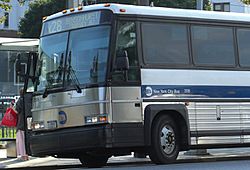
The center of Dyker Heights does not have its own New York City Subway station. However, you can walk 15-20 minutes to stations in nearby areas like Bay Ridge, Borough Park, or Bensonhurst.
- The BMT Fourth Avenue Line (R train) serves Bay Ridge with stations at Bay Ridge Avenue, 77th Street, 86th Street, and 95th Street.
- The BMT Sea Beach Line (N W trains) serves Borough Park with stations at Fort Hamilton Parkway and New Utrecht Avenue.
- The BMT West End Line (D train) serves Bensonhurst with stations at 79th Street, 71st Street, and 62nd Street.
Several local New York City Bus routes and two express routes serve Dyker Heights. These include the B1, B4, B8, B16, B64, B70, X28, X38 buses.
You can also reach Dyker Heights by car using the Belt Parkway and Interstate 278 (which includes the Verrazano-Narrows Bridge to Staten Island and the Gowanus Expressway).
Special Street Names
Many streets and corners in Dyker Heights are named to honor important people or events:
- Lieutenant William E. Coffey Square is at 81st Street between 7th Avenue and Fort Hamilton Parkway. It honors members of the armed forces.
- Marie Walsh Corner is at 84th Street and 7th Avenue. Marie Walsh was a dedicated community activist who helped start the X28 bus.
- Dyker Heights Boulevard is 13th Avenue between 86th Street and Bay Ridge Avenue.
- Firefighter Dennis Patrick O'Berg 9/11 Memorial Way is at 74th Street between 10th and 11th Avenues. It honors a firefighter who died on 9/11.
- Robert F. Tipaldi 9/11 Memorial Way is at 80th Street between 7th and 10th Avenues. It honors a trader who died on 9/11.
- Maria LaVache 9/11 Memorial Way is at 12th Avenue between Bay Ridge Parkway and 76th Street. It honors a receptionist who died on 9/11.
- Charles J. Mauro 9/11 Memorial Way is at 72nd Street between 11th and 12th Avenues. It honors someone who died on 9/11.
- Arturo Angelo Sereno 9/11 Memorial Way is at 12th Avenue and 67th Street. It honors someone who died on 9/11.
- Richard M. Caggiano 9/11 Memorial Way is at 80th Street between 10th and 11th Avenues. It honors someone who died on 9/11.
- Frederick I. Ergang Way is at 12th Avenue and Bay Ridge Avenue. He was a principal at P.S. 176 for many years.
- Det. Frank P. Collins Avenue is at 72nd Street and 7th Avenue. He was a police officer and Army sergeant.
- Giuseppe "Joe" Papandrea Way is at 86th Street between 15th and 16th Avenues. He was a leukemia survivor who died in a hit-and-run accident.
- De Russy Drive is a circular road in front of the Dyker Beach Golf Course Club House. It honors General Rene E. De Russy.
- Walter L. Johnson Corner is at 82nd Street and 11th Avenue. This corner is where Walter L. Johnson built his first house in Dyker Heights.
- Hank Vogt Way is at the intersection of 85th Street and 7th Avenue. Hank Vogt helped start the Bay Ridge Ambulance Volunteer Organization.
Churches in Dyker Heights
- Shrine Church of Saint Bernadette (Roman Catholic)
- St. Rosalia-Regina Pacis Parish (Roman Catholic)
- St. Ephrem's (Roman Catholic)
- St. Philip's (Episcopal)
- Lefferts Park Baptist Church (Independent Baptist)
Parks and Recreation
The southwest part of Dyker Heights has the Dyker Beach Park and Golf Course. This is a public park with an 18-hole golf course. It's a great place for outdoor activities.
Famous People from Dyker Heights
Many notable people have lived in Dyker Heights:
- Scott Baio (born 1960), actor
- Maria Bartiromo (born 1967), television host
- Anthony Fauci (born 1940), a top health expert who grew up here.
- Arnaldo Ferraro (born 1936), a politician.
- Wenjian Liu (1982–2014), an NYPD officer.
- Adam Ottavino (born 1985), a baseball pitcher.
- Joe Rollino (1905-2010), a famous strongman from Coney Island.
- Rosanna Scotto (born 1958), a TV news anchor.
Images for kids
See also
 In Spanish: Dyker Heights (Brooklyn) para niños
In Spanish: Dyker Heights (Brooklyn) para niños


